Faces of America
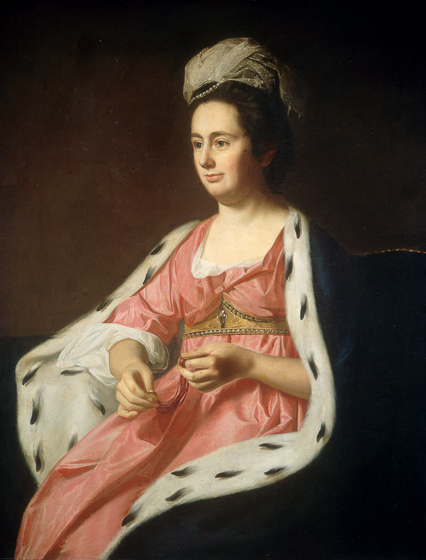
The sitter’s queenly bearing and costume distinguish this colonial portrait of Abigail Smith Babcock, a wealthy Bostonian. John Singleton Copley was a painter talented in both the art and business of his chosen trade. The colonial economy boomed over the course of the 18th century and produced a new class of wealthy Americans, some originally from England or the Netherlands, others born on American soil. While in America, Copley specialized in portraits of this new gentry, who were mercantile and landowning families. This new “aristocracy” was British by nationality and emulated the appearances and ways of the British upper class back at home, acquiring goods and fashions from England. Mrs. Babcock’s dress and ermine cape would have been over the top in either Boston or New Haven, where she married Mr. Babcock in 1764. Similar garments appear in several of Copley’s other portraits and it is known that he offered sitters a choice of fancy dress in which to be pictured, based on prints of fashionable people obtained from Europe. The artist was expert at rendering rich textures and colors, as seen in the drape of salmon-colored silk, soft fur, and bejeweled belt, among other accessories. Married couples often commissioned paired portraits to hang in their homes with large walls and high ceilings. A portrait of Adam Babcock is also in the National Gallery of Art collection and can be seen on the associated Pinterest board.
John Singleton Copley, Abigail Smith Babcock (Mrs. Adam Babcock), c. 1774, oil on canvas, Gift of Mrs. Robert Low Bacon, 1985.20.1
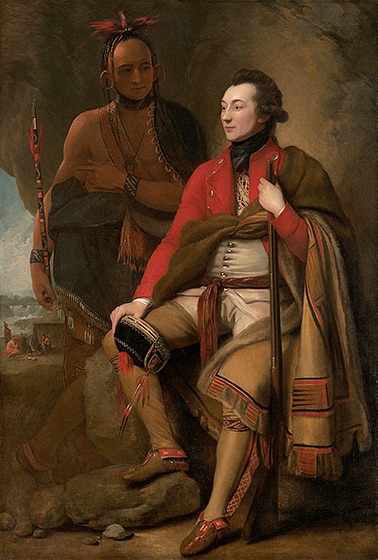
This image depicts what may seem an unlikely accord between a redcoat American colonist and a Native American. The painting’s details express their agreement: note that the men’s faces turn toward one another, expressions serious but not agitated in any way, and that their leg positions also mirror one another, a body language cue. Colonist Guy Johnson holds a musket at rest, while Native American Karonghyontye holds a calumet, also known as a peace pipe. You also may notice that Johnson integrates Native dress into his ensemble. What might this mean?
The complex relationship pictured here is between a British loyalist and a member of the Mohawk tribe, part of the Iroquois nation of today’s upstate New York and Canada. The British government and Iroquois forged a strategic alliance to fight against American revolutionaries and protect Native land. The Mohawks were known as fierce fighters and the British co-opted their strength to oppose American independence. In the painting, Johnson integrates Mohawk dress into his outfit to symbolize this alliance—yet the power relationship is not one of equals. Note how Johnson sits in the foreground, while Karonghyontye stands behind him, shadowed. Johnson’s rank was colonel and Karonghyontye’s assigned rank was captain. (Karonghyontye was also known as David Hill, his English name.)
The setting in the background may be Niagara Falls, which would correspond to the protection of Iroquois lands against the advance of the revolutionary colonists. A group of American Indians sits on the ground.
Benjamin West was an American painter who trained in Europe. It may be surprising that this picture was painted in London, where West started a successful studio and remained for the rest of his life. Guy Johnson and Mohawk delegates traveled to London together so that Johnson could receive his official commission as British superintendent of the Six Nations of the Iroquois, which included the Mohawk, Seneca, Onondaga, Cayuga, Oneida, and Tuscarora. The painting commemorates the occasion of Johnson’s appointment. It is not known whether Karonghyontye actually traveled to London, although his brother, also working with the British, was known to have done so. It is possible that he posed for the portrait in Karonghyontye’s stead.
Benjamin West, Colonel Guy Johnson and Karonghyontye (Captain David Hill), 1776, oil on canvas, Andrew W. Mellon Collection, 1940.1.10
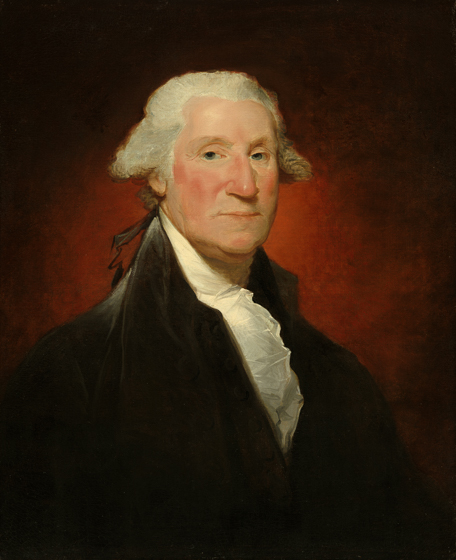
Gilbert Stuart painted this portrait of the first US president, which has become an indelible image. Stuart was an ambitious artist who left America to train in London under Benjamin West, a loyalist who moved to England when the revolution began stirring. Stuart spent time painting in London and later in Dublin, where he boasted to friends that he would return home to paint the president of the United States. He arrived back in New York in 1793 and secured portrait commissions from political figures such as John Jay, a founding father and first Chief Justice of the United States. (This portrait is also in the collection of the National Gallery of Art and can be seen on the related Pinterest board.) By 1795, Stuart was sitting down to paint George Washington (in office from 1789 to 1797). This is one of the first portraits Stuart painted, commissioned by John Vaughan as a gift for his father, who was a friend of Washington’s. It is known as the Vaughan portrait to distinguish it from the many other versions of the picture. Stuart went on to paint numerous portraits of US founders, including each of the first five presidents.
While most gentlemen of the period shaved their heads and wore powdered wigs on public occasions, Washington grew out his hair and powdered his natural, reddish-brown color white. The puffy sides give his head its familiar, triangular shape and the rest is pulled back and tied with an iconic ribbon. Gilbert captures a broad-shouldered, ruddy-faced, and serious president who eyes us directly, full of character and probity. The National Gallery of Art has a total of six Washington portraits; one known as the Vaughan-Sinclair version is a variation on the 1795 sitting Stuart was granted with the president, and others are variations on portraits now in other museum collections. Many were painted posthumously—Washington died at Mount Vernon in 1799, an event that inspired nationwide grief and many forms of homage. You may view the five other National Gallery of Art portraits on the associated Pinterest board. Compare the expressions and changes to the president’s appearance from picture to picture. Discuss which one you think best represents Washington and why. What other George Washington memorials exist in the United States?
Gilbert Stuart, George Washington (Vaughan portrait), 1795, oil on canvas, Andrew W. Mellon Collection, 1942.8.27
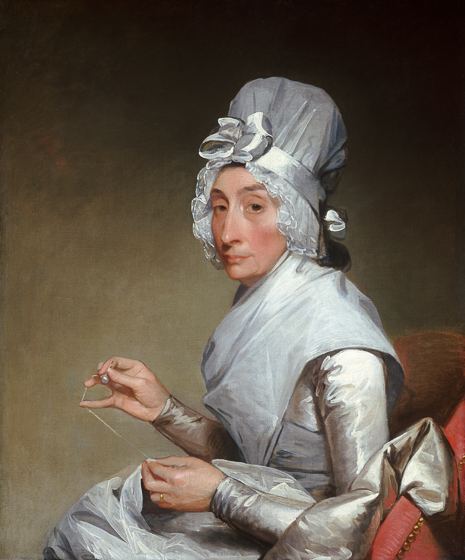
Gilbert Stuart worked successfully as a portraitist in England, Scotland, and America. In America, he found it necessary to adapt his Europeanized style, which tended toward idealization and grandeur, to the tastes of more conservative American clients. Catherine Brass Yates expressed to Stuart that she believed posing for her picture was a waste of time, and therefore is pictured sewing so it can be shown she spent her time wisely, communicating a disciplined and no-nonsense character. However, her lavish platinum-colored satin dress and ribboned cap, their sheen captured with the bright white highlights applied by the artist, leave no doubt that she is well-off. Catherine Yates’s portrait is a pendant to one Stuart painted of her husband, Richard Yates. When the portraits are side by side, she on the right, he on the left, they face toward one another. The background against which they are depicted is similar, suggesting that they occupy the same space. Further connecting the pair, she is seated in a soft red chair with brass rivets on the arm that echo the buttons of her husband’s sleeve. Other members of the Yates family were also painted by Stuart and are represented in the National Gallery of Art collection.
Gilbert Stuart, Catherine Brass Yates (Mrs. Richard Yates), 1793/1794, oil on canvas, Andrew W. Mellon Collection, 1940.1.4
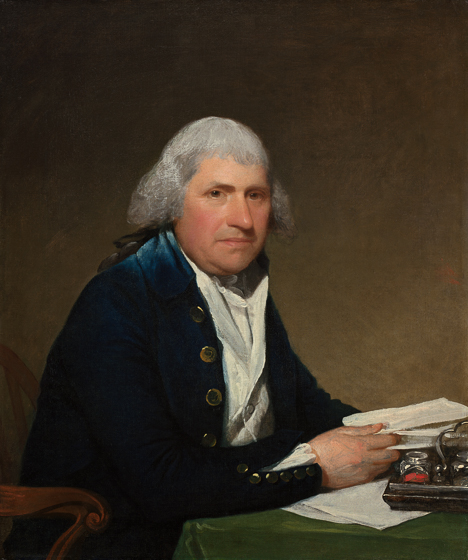
Gilbert Stuart painted the families and political figures of colonial and early America. This portrait of Richard Yates is pendant to one of his wife Catherine Brass Yates (Mrs. Richard Yates), shown in the previous slide. Mr. Yates also appears at work, with an inkwell and papers before him to convey industry and diligence. He was a merchant based in New York City, and imported goods from Great Britain and colonial Jamaica to the new republic. Yates wears a blue velvet jacket with brass buttons, its sumptuous textures and color made almost tactile by the artist, set off against a snowy white waistcoat. He wears the white powdered wig that men typically sported at the time, tied in the back with a ribbon, and some hair powder is visible on his shoulder if you look carefully. Seated in a carved chair before a table set with a green cloth Yates regards the viewer with an unsmiling, but not-unapproachable direct gaze.
Gilbert Stuart, Richard Yates, 1793/1794, oil on canvas, Andrew W. Mellon Collection, 1942.8.29
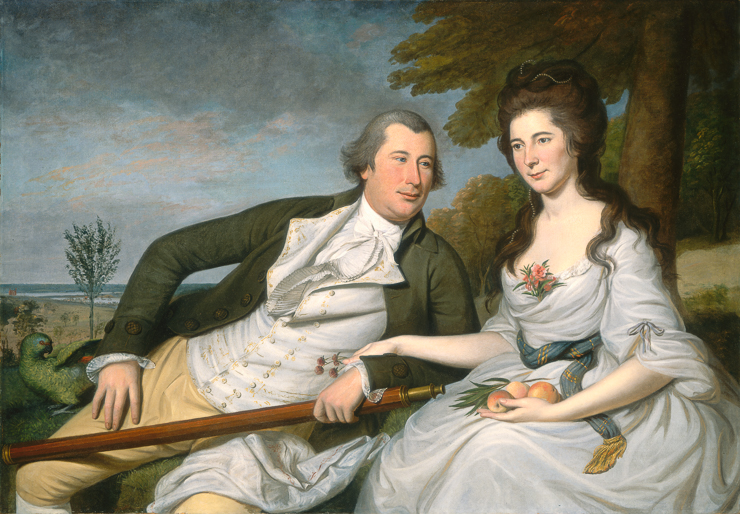
Contrast this double portrait of 1788 with a nearly contemporaneous pair of portraits by Gilbert Stuart, Richard Yates and Catherine Brass Yates. What differences can you can point out? Look at dress, expression, and the feeling that each picture conveys to you—is it serious, romantic, or straightforward? Are there props or symbols that represent the subjects? Do you notice any other unusual elements in the pictures?
Benjamin and Eleanor Ridgely Laming and some of its details are inspired by a romantic poem from the Italian baroque period (La Gerusalemme liberata by Torquato Tasso) about a couple, Rinaldo and Armida.
The Lamings were wealthy merchants who lived on an expansive estate near Baltimore. Eleanor Ridgely Laming was related to Eliza Ridgely, pictured in an 1818 portrait by Thomas Sully. The Ridgelys were also a prominent and wealthy Baltimore-area clan.
The Peale family formed an artistic dynasty based in Philadelphia. Charles Willson Peale studied under Benjamin West and during the revolution served with the Pennsylvania militia. He enjoyed the friendship of the inner circle of founding fathers, such as George Washington and Thomas Jefferson, as well as the Marquis de Lafayette. Charles’s brother James, nephew Charles Peale Polk, and niece Anna Claypoole Peale were also painters. Charles Willson Peale ambitiously named several of his children after famous European Renaissance and baroque artists: Raphaelle, Rembrandt, Rubens, Titian, Rosalba (after Rosalba Carriera, a Venetian miniature painter), and Sophonisba (after Sofonisba Anguissola, who worked in Rome) were among his 17 children. Several became noted artists or achieved a high level of accomplishment in other fields.
Charles Willson Peale, Benjamin and Eleanor Ridgely Laming, 1788, oil on canvas, Gift of Morris Schapiro, 1966.10.1
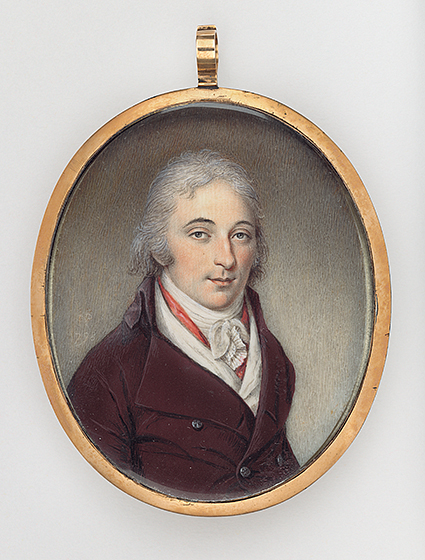
This portrait and the work on the next slide are pocket-sized miniature paintings meant to be worn like a piece of jewelry or carried on a chain. Each is a tiny watercolor painting meticulously executed on ivory, a slippery surface upon which to paint, and preserved under glass. The ivory painting surface was thought to lend luminosity to the portraits. The reverse side of the miniature contains intricately woven locks of hair, preserved under glass with gold filigree initials affixed. (You may view images of the backs of the miniatures on the Pinterest board.)
The woven locks underscored the intimate nature of the tokens as personal keepsakes of their owners; social conventions prescribed that miniatures be exchanged only between spouses and family members. On the Pinterest board, you can see a painting of a woman, Deborah McClenachan (Mrs. Walter Stewart), 1782, by Charles Willson Peale, who is wearing portrait miniatures of her husband and father. This miniature may portray Alexander Kerr, a banker in Washington, DC, and could have been intended for a wife, sister, or mother to wear.
James Peale, A. T. Kerr, Esquire, 1798, watercolor on ivory, Corcoran Collection (Bequest of Sarah A. Hagner), 2015.19.2480
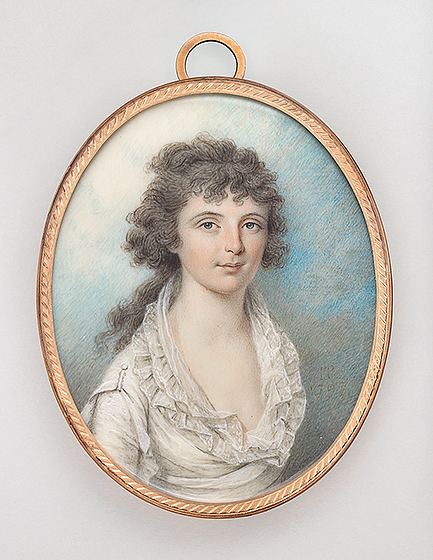
Marcia Burns was a member of a wealthy family that owned much of the land that was eventually purchased by the federal government to create Washington, DC. By 1802, she was married to a US representative from New York, John P. Van Ness. Van Ness later served in a military capacity and as mayor of Washington, DC.
The artist, James Peale (1749–1831), came from the multiply talented Peale family of artists, scientists, inventors, and patriots (who served in the Revolutionary War) prominent in Philadelphia and the mid-Atlantic region during the late 18th and early 19th centuries. (See the Pinterest board for a portrait of the artist.) At the time that these two miniatures were painted (1797 and 1798), James Peale was at the height of his career. He painted many of the country’s founders, military figures, and other prominent (and wealthy) people including George Washington, James Monroe, and Andrew Jackson. Family members also frequently sat for portraits. Peale specialized in portrait miniatures and made over 200 in his lifetime. In the family tradition, Peale trained his daughter, Anna Claypoole Peale, in the art, and she succeeded him as a successful and in-demand portrait miniaturist in her own right. Miniatures became popular in the United States as the number of wealthy individuals grew, and through a desire for remembrances of loved ones in times of separation—whether due to distance, war, travel, or even death.
James Peale, Marcia Burns, 1797, watercolor on ivory, Corcoran Collection (Gift of Mrs. Philip Hinkle), 2015.19.2478
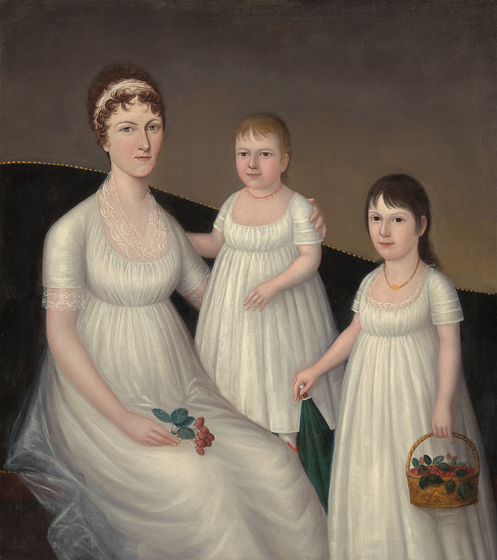
Joshua Johnson was among the first African American artists to achieve professional success and recognition in the United States during the early part of the 19th century. He was enslaved for part of his life and emancipated in the 1780s. While establishing his career as a painter, he was listed in Baltimore city records, where he lived, as a “Free Householder of Colour.” He may have studied with Charles Peale Polk, the nephew of Charles Willson Peale, from a family of prominent Philadelphia artists. While Johnson’s subjects were largely white, there are two known portraits of African American subjects. You may find one of the portraits on the associated Pinterest board.
Joshua Johnson, Grace Allison McCurdy (Mrs. Hugh McCurdy) and Her Daughters, Mary Jane and Letitia Grace, c. 1806, oil on canvas, Corcoran Collection (Museum Purchase through the gifts of William Wilson Corcoran, Elizabeth Donner Norment, Francis Biddle, Erich Cohn, Hardinge Scholle and the William A. Clark Fund), 2014.136.146
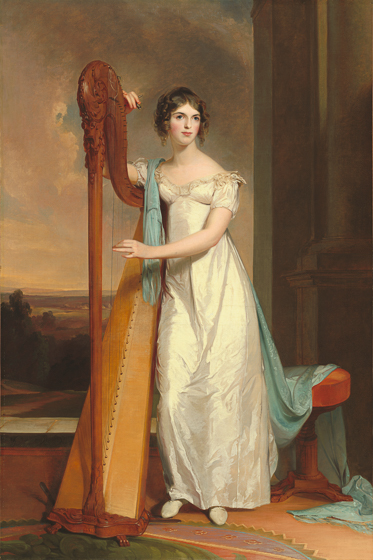
Only the wealthiest families could afford a grand portrait like Lady with a Harp, which is 7 feet tall. In addition to the expense of the commission, the portrait required a capacious home with wide walls and tall ceilings. Eliza Ridgely was a 15-year-old student at a boarding school in Philadelphia. Her father hired Thomas Sully, who was based in Philadelphia, to paint her portrait. At the time, Sully was one of the most popular and prolific portraitists of his age, whose talent lay in his ability to idealize and flatter his sitters. Here, the sitter appears almost like a goddess with her harp, her figure elongated and graceful. When the picture was completed, it was exhibited briefly at the Philadelphia Academy of Fine Art as “Young Lady with a Harp,” and then traveled to its final destination, the family’s home in Towson, Maryland, outside of Baltimore. It was carried there by a young Philadelphian artist, Rembrandt Peale, whose work is represented in elsewhere in this slide set.
Eliza Ridgely really did play the harp, as staged as this portrait may seem; hers was a rare instrument imported from London for her by her father. At the time, the Ridgely family was among the richest in the United States, rivaling George Washington’s. An earlier generation of Ridgelys prospered during the Revolutionary War by manufacturing cannons for the patriots. Later generations succeeded in agriculture, livestock, and mercantile pursuits and became prominent in politics and government.
Thomas Sully, Lady with a Harp: Eliza Ridgely, 1818, oil on canvas, Gift of Maude Monell Vetlesen, 1945.9.1
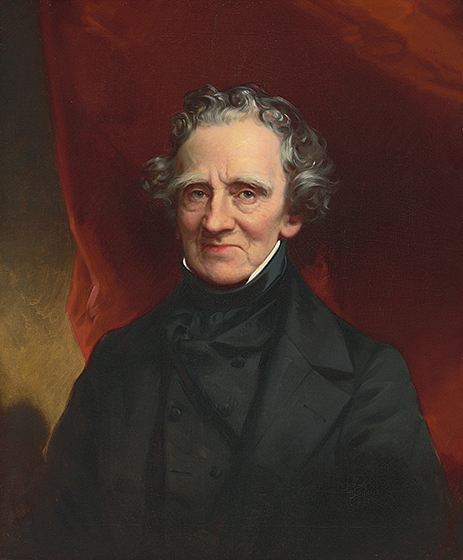
Thomas Sully’s self-portrait was completed years after his portrait of Eliza Ridgely. Sully had an extraordinarily productive career, painting some 2,500 works, mainly portraits, during his lifetime. If you compare the dimensions of this work to those of the previous painting of Eliza Ridgely, you will find that it is relatively small.
Sully’s self-portrait shows him as a prosperous and confident artist. While he has painted himself at small scale, the style of the portrait makes conscious reference to other famous portraitists in the history of art whom he admired, including British portraitists Sir Henry Raeburn and Sir Thomas Lawrence who painted the British aristocracy.
Thomas Sully, Self-Portrait, 1850, oil on canvas, Corcoran Collection (Gift of William Wilson Corcoran), 2015.19.112
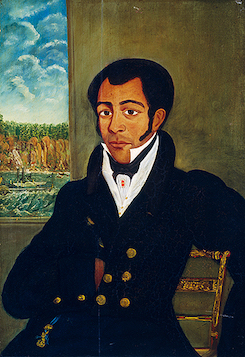
This is a rare early American portrait of a black man. Although the names of the artist and the sitter are not known, the picture offers a few clues. Through the open window, you can see a steamer plying a river and palisades and woods beyond. The ship is the New Philadelphia, a passenger steamer that traveled between Albany and New York City on the Hudson River, breaking records by completing the trip in nine hours. It was one of the first commercial passenger lines to employ African Americans as stewards and waiters, and the uniformed man pictured proudly associates himself with the ship line. He sits on a Hitchcock chair, a type of painted, wooden chair made in Connecticut at that time (the company continues today). Note the gentlemanly hand-in-waistcoat gesture—the same pose appears in an earlier portrait by Robert Feke on the related Pinterest board. There is another portrait very similar to this one in another museum collection (included on the Pinterest board). It has been suggested that the two men are brothers or somehow related.
American 19th Century, Portrait of a Ship's Steward, probably 1829, oil on wood, Gift of Edgar William and Bernice Chrysler Garbisch, 1953.5.22
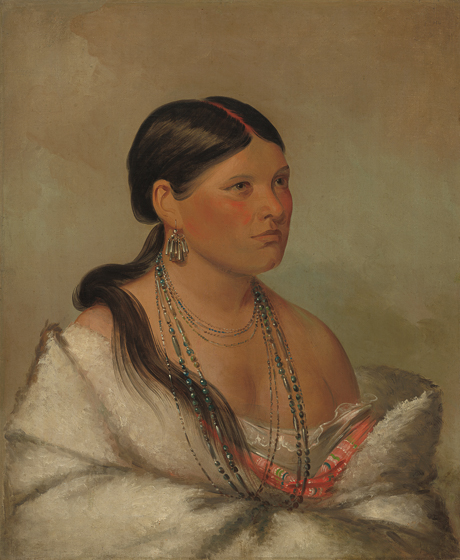
From 1830 to 1860, artist George Catlin traveled extensively across North and South America on a mission to record, through painting, Native people and their ways of life, which he saw as disappearing. In 1830, President Andrew Jackson passed the Indian Removal Act, which forcibly displaced Native Americans from lands east of the Mississippi and threatened the survival and existence of many tribes. Catlin often traveled with government expeditions, including those of William Clark, who (with Meriwether Lewis) was tasked by President Thomas Jefferson to explore the lands claimed through the Louisiana Purchase and forge relationships with Native American tribes that occupied the lands. The young woman pictured here seems also to appear in a group portrait, Shawano Indians, 1861/1869. In the text accompanying that work, she is identified as the daughter of a chief.
Catlin produced about 500 portraits for what he called his “Indian Gallery,” plus many other works that he designated as the “Cartoon Collection” since those works were based upon outline drawings he had made during the 1830s. It was Catlin’s lifelong dream to sell the Indian Gallery works to the US government. Despite his efforts, he was unable to interest Congress in their purchase. Ultimately, Catlin died in debt in London, where he been exhibiting his pictures commercially, charging an admission fee. A patron paid off Catlin’s debts and donated the paintings to the Smithsonian Institution, which holds the majority of his works. In 1965, 351 works were contributed to the National Gallery of Art collection.
George Catlin, The Female Eagle - Shawano, 1830, oil on canvas, Paul Mellon Collection, 1965.16.348
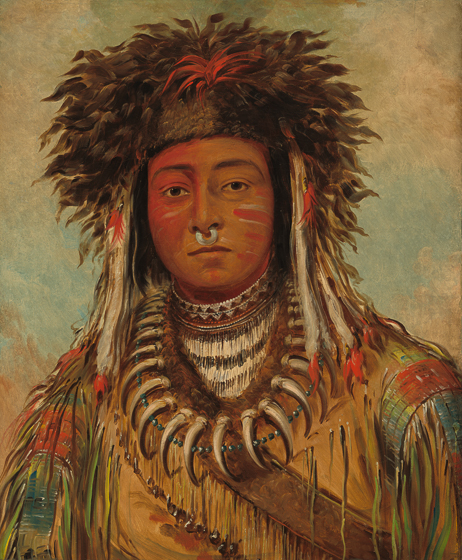
The painter George Catlin feared the annihilation of Native Americans due to the passage, during his lifetime, of U.S. laws that violated the autonomy of Native tribes. This drove him to his mission to visit over 50 tribes across the midwest and plains to document people whose way of life was threatened. Seen through today’s lens, his project can be seen in some respects as exploitative. At the same time, Catlin’s art offers an important record, in the time before photography, of specific Native people and their culture in a way that belied the racist ideas of Native Americans that circulated widely in the 19thcentury. The explorer William Clark attested to this: “I have seen Mr. Catlin’s collection of portraits of Indians, many of which were familiar to me, and painted in my presence…the likenesses are easily recognized, bearing the most striking resemblance to the originals, as well as faithful representations of their costumes.” In 20th century the works came to be reevaluated as works of art in addition to being important documents. Locate the region associated with this tribe during the period Catlin painted this work
George Catlin, Boy Chief - Ojibbeway, 1843, oil on canvas, Paul Mellon Collection, 1965.16.349
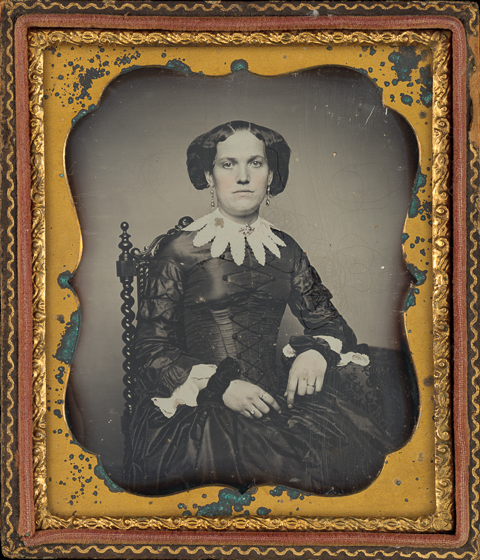
Augustus Washington was an African American photographer who worked with daguerreotypes, one of the earliest forms of photography. Washington, the son of a former slave, learned to make and sell daguerreotype portraits to help pay for his education at Dartmouth College. He eventually opened his own studio in Hartford, Connecticut, and later moved with his family to Liberia, where he also set up a portrait studio. He is famous for capturing an early photograph of abolitionist John Brown.
Daguerreotypes produced single, unique images. The treated surface that was exposed to light became the final work (analogous to a Polaroid camera photo). Due to their unique qualities, and to help market the images as valuable and precious, daguerreotypes were often encased in elaborate, sealed frames and velvet-lined boxes. Like many painted portraits of the period, subjects were largely unsmiling. This quality may be magnified in looking at older photography through contemporary eyes, since many people today are trained from childhood to smile for photos.
Augustus Washington, Portrait of a Woman, c. 1850, daguerreotype, Robert B. Menschel and the Vital Projects Fund, 2015.97.1
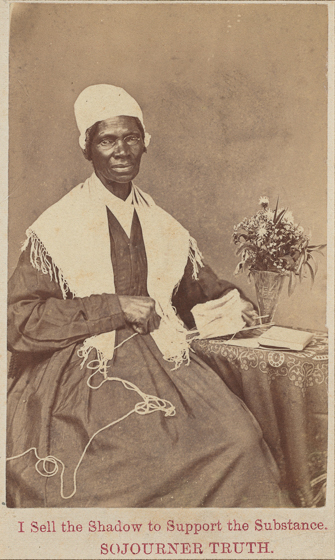
Calling cards, known as cartes-de-visite, were inexpensive cards you could have printed of yourself to trade with others. Calling cards circulated widely during the 19th century. The invention of the photographic negative in the 1850s allowed for the production of cheap, duplicate copies of a single image. You could even collect the calling cards of famous people.
Such was the case for Sojourner Truth’s calling card. Formerly enslaved, she became an outspoken abolitionist and supporter of women’s suffrage. Truth (born Isabella Baumfree, 1797–1883) sold her image to support her advocacy efforts. To ensure that purchasers understood her intent, she printed a motto at the bottom, “I Sell the Shadow to Support the Substance.” Discuss what Truth meant by this metaphor. The practice also helped spread her fame and information about her causes. How do 19th-century calling cards relate to how we exchange and share images of one another today?
American 19th Century, Sojourner Truth, 1864, albumen print mounted on card (carte-de-visite), Pepita Milmore Memorial Fund, 2014.19.1
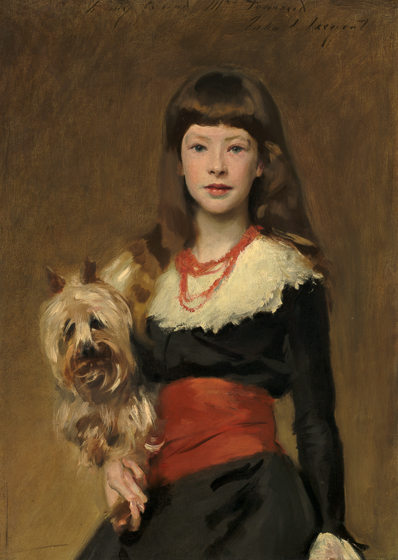
John Singer Sargent enjoyed an illustrious career as a portraitist during the Gilded Age (the term coined by Mark Twain in his 1873 book, Gilded Age), a period of opulent living and accumulation of wealth by a few who wielded outsize political influence to their personal benefit. Sargent and the Townsends were part of an international network of expatriate Americans who enjoyed life and extended stays in Europe. This work was likely painted in Paris, where the New York–based Townsends had a home, and where Sargent lived from 1874 until about 1886, when he moved to London. He spent much of his life abroad.
This young woman, aged 12, was one of seven children of a friend of Sargent’s. Painted in a spontaneous way with broad brushstrokes, rather than fine detail, the work conveys a snapshot-like quality, as if Beatrice Townsend had just then decided to scoop up her small mop of a dog to be in the portrait with her. The casualness of the gesture and pose seem real and warm, the girl’s gaze direct and confident, allowing the viewer a glimpse into Beatrice’s privileged life. She died only two years later of an infection.
John Singer Sargent, Miss Beatrice Townsend, 1882, oil on canvas, Collection of Mr. and Mrs. Paul Mellon, 2006.128.31
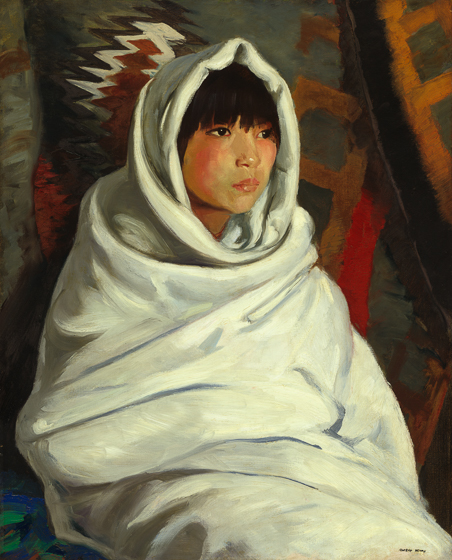
Robert Henri and George Bellows (his work Little Girl in White (Queenie Burnett) appears on the following slide), who were first teacher and student, and then peers, were devoted to depicting a realist view of modern, urban life at the beginning of the 20th century that was inclusive of people of different ages, races, and walks of life.
Henri traveled several times to Santa Fe, New Mexico where he painted Latino and Native American subjects, including this young woman, Julianita, who was enrolled in an Indian school near his art studio. He painted her in a posed setting amid rugs of Native design, wrapping a white blanket around her for effect. His purpose was purely artistic: Henri noted of his work in the American southwest, “I do not wish to explain these people, I do not wish to preach through them, I only want to find whatever of the great spirit there is in the Southwest. If I can hold it on my canvas, I am satisfied.”
Robert Henri, Indian Girl in White Blanket, 1917, oil on canvas, Corcoran Collection (Museum Purchase, Gallery Fund), 2014.136.17
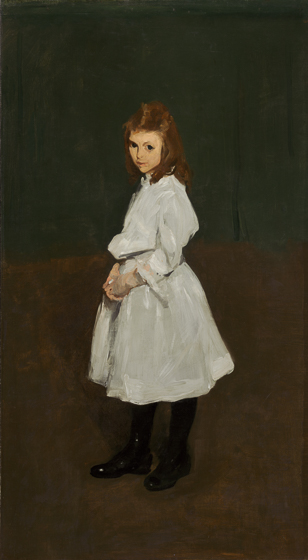
George Bellows was the student of Robert Henri, whose work Indian Girl in White Blanket is pictured on the previous slide. Bellows’s picture of Queenie Burnett, sad-faced and perhaps shy in posing for a portrait, was originally entitled Little Laundry Girl. The painting is unusual in that her portrait is life-size (about 5 feet tall) and shows the entire figure (full-length, rather than cropped like Indian Girl in White Blanket). Large-scale, full-length portraits were historically reserved for wealthy or powerful individuals. We know less about Indian Girl, who is shown amid colorfully patterned textiles that may relate to her heritage. Her small, guarded face looks into the distance beyond the picture, and she is wrapped up in a white blanket or covering, presumably for warmth. We may wonder what her young eyes have seen and witnessed.
Compare Little Girl in White (Queenie Burnett) to Lady with a Harp: Eliza Ridgley (1818) by Thomas Sully and Miss Beatrice Townsend (1882) by John Singer Sargent, all found elsewhere in this slide set.
George Bellows, Little Girl in White (Queenie Burnett), 1907, oil on canvas, Collection of Mr. and Mrs. Paul Mellon, 1983.1.2
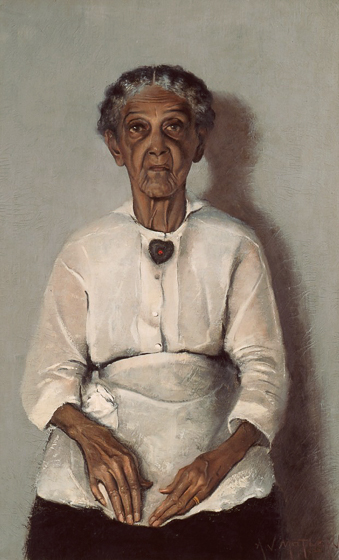
The extended family of Archibald Motley Jr. moved from New Orleans to Chicago in 1894. The group included the artist’s paternal grandmother, Emily Motley, pictured here. Her son, Archibald Motley Sr., worked as a Pullman porter on the Michigan Central Railroad and his wife, Mary L. Motley, was a schoolteacher. Their professions were among the highest-status and best-paying jobs black Americans could hold at the time.
The artist was one of the first African Americans to attend the School of the Art Institute of Chicago (from 1914 to 1918), where he also worked as a janitor to defray costs. Following graduation, Motley elected to focus his art on themes around black American life. This portrait of his grandmother, who was born into slavery in Kentucky in 1842, is venerable and dignified, the effects of time and hard work visible on her hands and face. She lived until she was 87 years old. The work, completed when Motley was still an unknown, may have been painted on a cast-off Central Railroad laundry bag from his father’s train line. Motley admired Aaron Douglas’s more stylized works, which were influenced by the forms of African sculpture and cubist art. He eventually adopted a highly colored, stylized approach in his later work (you may find examples on the related Pinterest board).
Archibald John Motley Jr., Portrait of My Grandmother, 1922, oil on canvas, Patrons' Permanent Fund, Avalon Fund, and Motley Fund, 2018.2.1
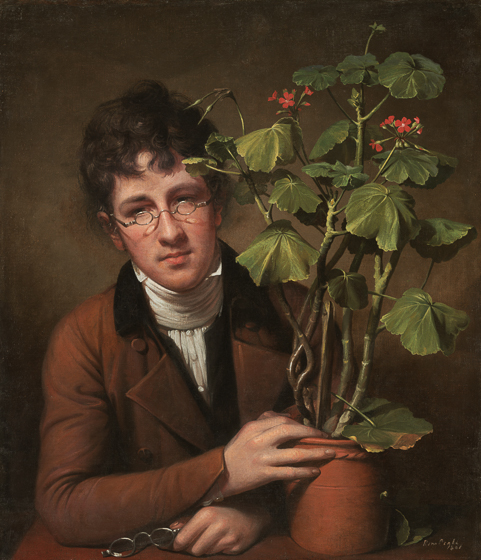
In portraits, people are sometimes pictured with objects and props that have personal meaning to them. The portrait on this slide and on the slide following (Stieglitz’s Georgia O’Keeffe) from different centuries share qualities: in each, the subject has chosen a plant or fragment of one as a prop. In the history of art, different plants symbolize various abstract qualities such as fidelity, purity, or loyalty. Here, the plants relate directly to each sitter’s intellectual pursuits and interests. In addition, the paintings were intimate portraits created by artists close to the sitter.
Rubens Peale is portrayed by his brother, Rembrandt Peale, with an object of his study, a geranium, that reflects his interests as a naturalist. The plant pictured is said to be the first geranium grown in America—until then, geraniums were exotic rarities. The studious image includes two pairs of glasses, a reference to Rubens’s weak eyesight that left him unable to pursue a career as an artist alongside his siblings. He did remain in the family business however and became director of the Philadelphia Museum in 1810. The Philadelphia Museum (unrelated to today’s Philadelphia Museum of Art) was founded by Charles Willson Peale in 1784 as the country’s first public museum. It was a gallery designed to display his paintings, but also encompassed his interest in natural history, with a collection of exotic specimens collected by explorers. Rubens later also served as director of the Peale Museum, an offshoot in Baltimore.
Rembrandt Peale, Rubens Peale with a Geranium, 1801, oil on canvas, Patrons' Permanent Fund, 1985.59.1
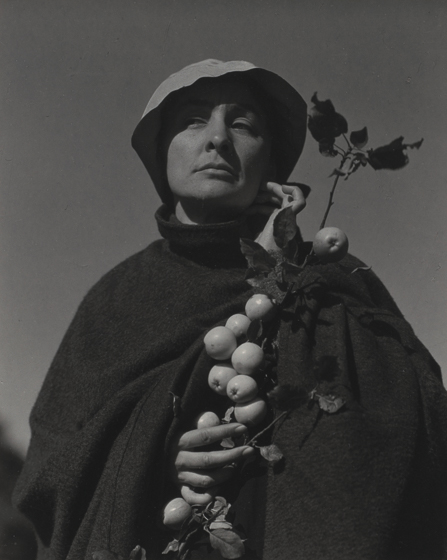
In this portrait, modern abstract artist Georgia O’Keeffe is pictured by a loved one, in this case her partner Alfred Stieglitz, a photographer and gallerist whom she married in 1924, the year this photo was taken. Stieglitz continued to photograph her for many years, eventually creating 300 images of his wife. She noted that Stieglitz’s idea of a portrait was “not just one picture.” O’Keeffe looks regal in this image, which was taken from a low vantage point. She gazes thoughtfully off to the side while supporting a branch of a tomato or other fruit-bearing plant, which bears symbolic meaning. Like the Peales (see previous slide), O’Keeffe was a close observer of nature, seeking to discover, through her art, its essential forms. Her interest was not scientific, but almost spiritual, in that she felt nature offered windows into whole autonomous worlds. You can see images of her art on the Pinterest board.
Alfred Stieglitz, Georgia O'Keeffe, 1924, gelatin silver print, Alfred Stieglitz Collection, 1980.70.175
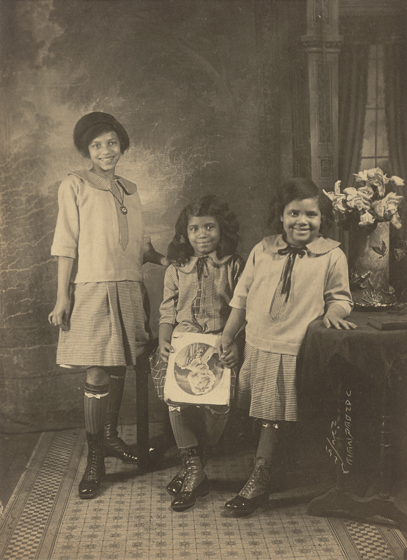
James Van Der Zee operated a portrait studio in Harlem, New York, intermittently from about 1916 until 1968. His extensive body of work forms an important chronicle of the Harlem Renaissance, a surge in cultural activity among African Americans including visual artists, writers, musicians, actors, and playwrights. During the 1920s, Van Der Zee attracted couples and families to his portrait studio, documenting the rise of a black middle class. He also took his camera to the streets, homes, churches, and clubs of Harlem’s residents, providing a comprehensive look at a thriving black community.
The three girls pictured all wear variations of the same outfit, down to their footwear. The girl in the center seems to be clutching a favorite object, which may be a record album.
James Van Der Zee, Sisters, 1926, gelatin silver print, Robert B. Menschel Fund, 2000.83.2
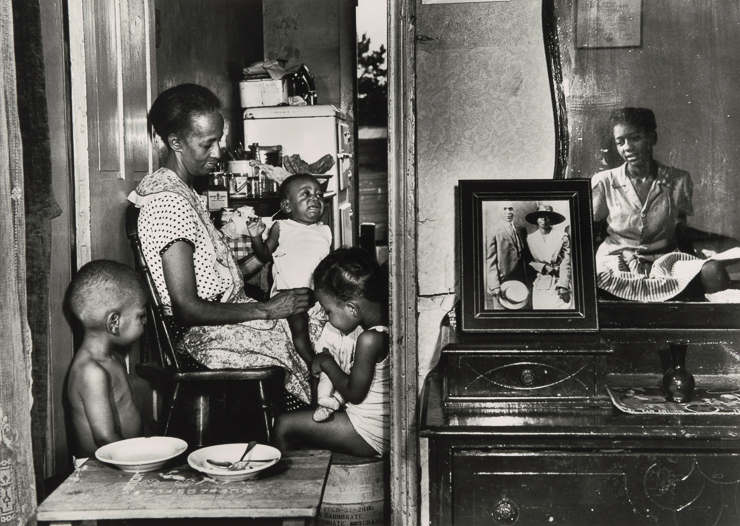
Gordon Parks was working in Washington, DC, as a documentary photographer for the Farm Security Administration when he met Mrs. Ella Watson, who was a char, or cleaning, woman in the government offices where he worked. He decided to make her the subject of what turned out to be a series of 90 photographs about her work, personal, and family life. It was an extraordinary series of photographs for the time because it portrayed the life of a poor, black woman, her workday and twin occupations of family and faith.
Gordon Parks, Washington, D.C. Mrs. Ella Watson, a government charwoman, with three grandchildren and her adopted daugther, July 1942, gelatin silver print, printed later, Corcoran Collection (The Gordon Parks Collection), 2016.117.106
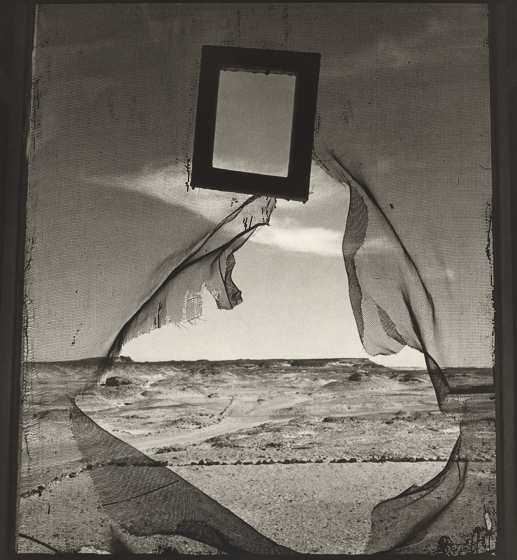
In this unusual portrait, the space delineated by a torn screen suggests the place where, typically, a person would be posed. Perhaps the subject has escaped through the opening. An empty picture frame dangles where a head might be positioned. Photographer Lee Miller seems to reflect back at us our expectations of what a portrait “should” be, instead offering an empty, dreamlike landscape in which to project our own ideas and presence.
Lee Miller, Portrait of Space, near Siwa, Egypt, 1937, gelatin silver print, 1989, Gift of Gaillard F. Ravenel and Frances P. Smyth-Ravenel, 2000.7.37
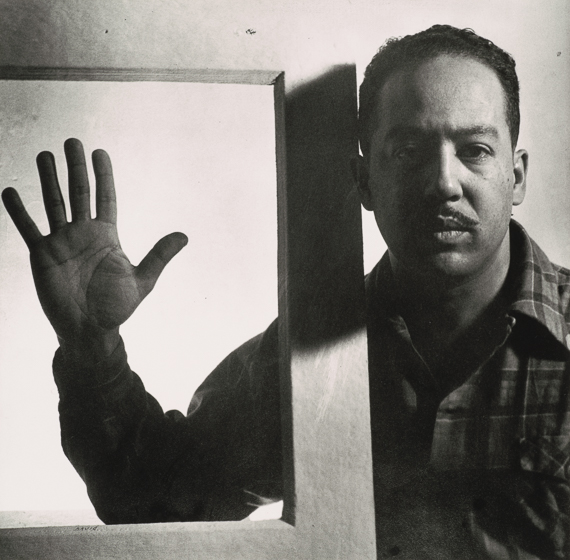
Langston Hughes, a poet, essayist, and advocate for social justice associated with the Harlem Renaissance, is pictured in a portrait by Gordon Parks, an African American photographer and musician. The image is stark, serious, and confrontational. It is as if Hughes has shifted his own face out of the portrait frame to address you, the viewer, directly. His upraised hand—which could be read symbolically as stop, help, or surrender—remains within the frame and behind an invisible barrier.
Gordon Parks, Langston Hughes, Chicago, December 1941, gelatin silver print, printed later, Corcoran Collection (The Gordon Parks Collection), 2016.117.102
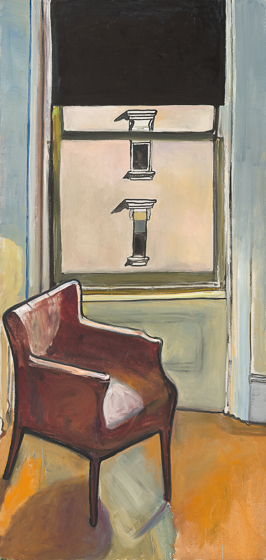
Alice Neel was an accomplished and prolific portraitist, who painted family, friends, fellow artists, and people from all walks of life with whom she came into contact in everyday life. She painted in a stark, uncompromising fashion that was honest and concealed no flaws. Her subjects posed specifically for her portraits in a slightly self-conscious and awkward way. She painted people as they were or appeared to her: sometimes slumped, or upright and stiff in her studio chairs. You may find additional images of the artist and her work on the related Pinterest board.
Poignantly, here, her chair is empty, although the light coming through the window and shining on the chair seems to animate the scene. Do you think the painting is an expression of the artist’s own feelings or meant to capture the quality of loneliness itself?
Alice Neel, Loneliness, 1970, oil on canvas, Gift of Arthur M. Bullowa, in Honor of the 50th Anniversary of the National Gallery of Art, 1991.143.1
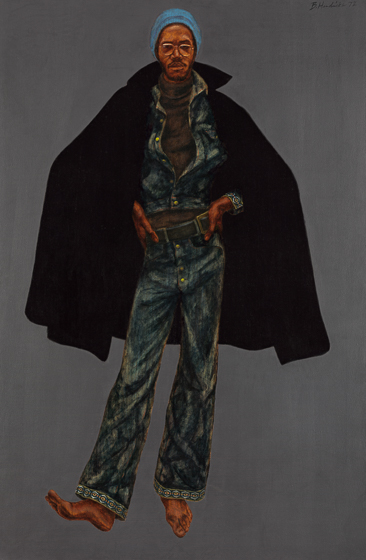
Barkley Hendricks mostly painted full-length portraits of African American sitters, often decked out in their favorite styles, proudly and confidently asserting their individuality. His work coincided with the Black Power era of the 1960s and 1970s, during which black Americans publicly demonstrated to assert their visibility and political rights. Hendricks’s subjects were not celebrities or artists; they were ordinary people, friends, and neighbors. George Jules Taylor was a student in a painting class that Hendricks taught at Yale University, where the artist earned an MFA degree in 1972. Taylor is the entire focal point, against a flat, monochromatic gray backdrop. The figure stands out very strongly as a result—the wings of his cape flaring out dramatically as Taylor tilts his body, a single bare foot outstretched, hands at hips, elbows out. Hendricks arrived at his project of painting monumental portraits following time he spent as an art student in Europe, studying old master art. He became fascinated by large-scale, “grand manner” portraits of aristocrats and the gradations of the color black represented in their clothing. What he found absent, however, was the representation of black subjects, other than as enslaved people or servants in the background. He set about to address this imbalance through his art.
Barkley Leonnard Hendricks, George Jules Taylor, 1972, oil on canvas, William C. Whitney Foundation, 1973.19.2
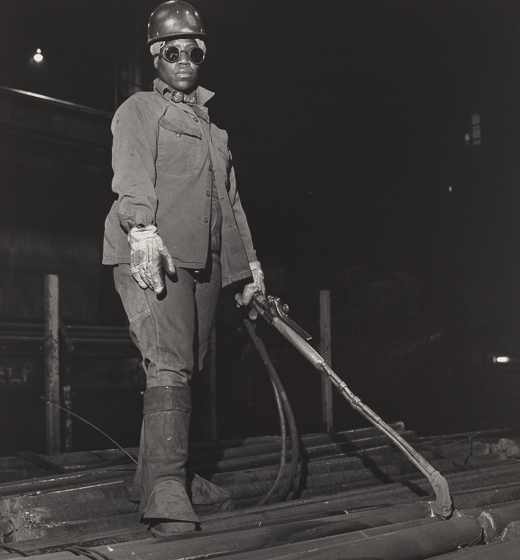
This image and those on the two following slides focus on Doris McKinney and her family. They are part of a series of portraits taken by photographer Milton Rogovin of steelworkers in and around his hometown of Buffalo, New York, beginning in the 1970s. Doris McKinney was a single, divorced mother hired by Republic Steel in 1977. She was referred by a work incentive program attached to the family welfare benefits she was receiving at the time. McKinney was part of a wave of female hires that resulted from an Equal Employment Opportunity Commission ruling that identified hiring discrimination at a number of steel mills and required affirmation action hiring (of women, minorities, and protected classes of people) to address it.
Rogovin also worked with an oral historian, Michael Frisch, to record the worker’s explanations about their work and other stories, material compiled with the photos in a book called Portraits in Steel. McKinney said of this picture: “Most of my friends that saw this picture, they'd say I look like I was from outer space. But at the time, I was working at Republic Steel and I was a burner, so this is my burning outfit, because you have to have long sleeves, because the sparks are flying, shields on the shoes, you know. And this is a burning torch, and what it is, is these are pieces of steel that haven't met up to the specifications, they're quite long, so they burn them in sections so that the crane can pick them up, and they'd be placed in boxcars and shipped out. I think they melt them back down. And there's the burning goggles, and the reason the hat's sitting so high is I guess because I had my hair rolled up [laughs]. Because you know when you get off from work, you always still try to be a lady, even though you’re working in a man’s job, doing a man’s job, when you take off all of this here, you still want to be a woman.”
Milton Rogovin, Doris McKinney, Republic Steel (Working People series), 1978, gelatin silver print, Gift of Dr. J. Patrick and Patricia A. Kennedy, 2011.145.55
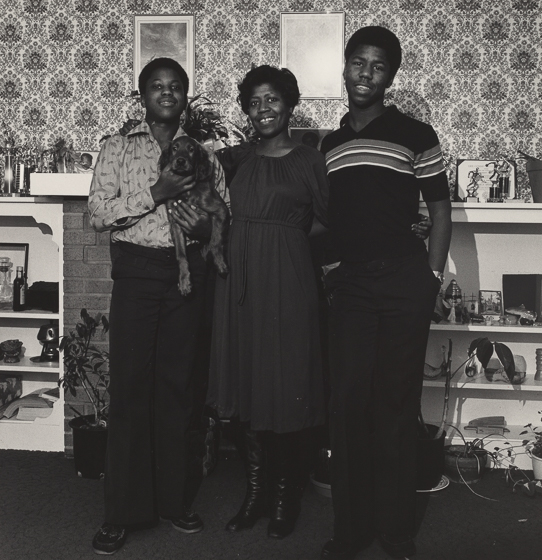
Milton Rogovin cultivated trust and ongoing relationships with his subjects. He went with them to their workplaces and to their homes and into their livingrooms, seeing his working subjects in their off-hours, enjoying the company of family and showing pride in their home. He often returned to photograph people multiple times, as he did with the McKinney family (pictured in the following slide nearly 10 years later).
The critic Hilton Kramer reviewed an exhibition of Rogovin’s photography, saying, “His subjects. . .are invited to pose for the camera, and they respond with pride, bravado, dignity, humor, even shyness, in a way that testifies to the empathy and good will of the photographer. . . .The result is a remarkably vivid account of particular lives as they are lived in a particular place, and a very moving account it is, too.”
Milton Rogovin, Doris McKinney at Home, Republic Steel (Working People series), 1978, gelatin silver print, Gift of Dr. J. Patrick and Patricia A. Kennedy, 2011.145.56
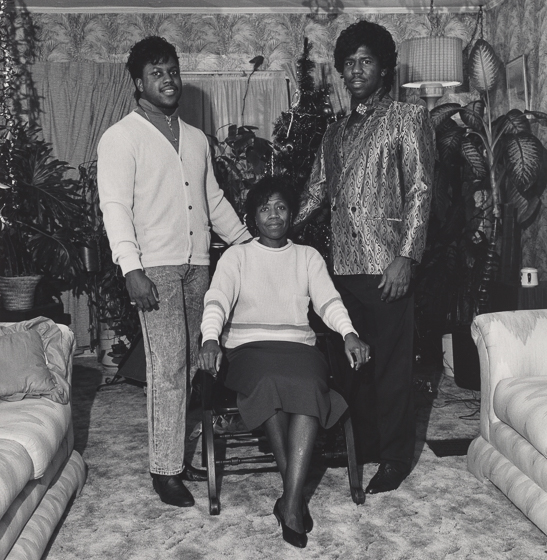
Milton Rogovin photographed steelworker Doris McKinney and her family multiple times, recording work and home life, as well as time elapsing. Rogovin was a lifelong activist and advocate for working-class people, such as miners and steelworkers, whose lives he chose to exclusively depict in his photography. His daughter said of Rogovin and his wife Anne, “they believed in humanity, they believed that people had the right to have a decent job with privileges that working people should have, like health care and wages that were decent.” What changes can you observe in the McKinney familly from 1978 (previous slide) to 1987?
The Library of Congress honored the artist by acquiring Rogovin’s entire archive, inclusive of nearly 30,000 negatives, prints, and other documents, in 1999.
Milton Rogovin, Doris McKinney with Her Two Sons, Republic Steel (Working People series), 1987, gelatin silver print, Gift of Dr. J. Patrick and Patricia A. Kennedy, 2011.145.57
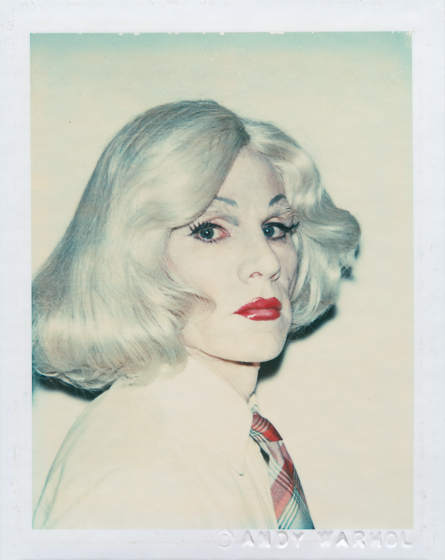
By the 20th century, portraiture as an artistic genre had declined. Photography allowed anyone to make a portrait (or self-portrait), and artists who accepted portrait commissions were seen as commercial artists who were not creatively independent. Andy Warhol helped revive the genre during the 1970s, when he began creating his famous silkscreen portraits of celebrities, society people, and himself. He embraced the commercial associations of the genre and charged accordingly when he discovered there was high demand for his portraits. Warhol’s portraits came to embody the sitter’s status and wealth, just as they traditionally had in colonial America. His self-portraits helped insert his own image among the wealthy and famous people he admired and emulated. This image looks like a more personal one, a simple Polaroid snapshot. In it, Warhol embraces gender ambiguity, with bright red lips and heavy eye makeup and a man’s shirt and tie. Note that the Polaroid bears a copyright symbol in recognition of the commercial value of his image.
Andy Warhol, Self-Portrait, 1981–1982, dye diffusion transfer print (Polacolor), Glenstone in honor of Eileen and Michael Cohen © 2009 The Andy Warhol Foundation for the Visual Arts / ARS, New York, 2008.30.47

Throughout his life, Warhol turned his camera on himself—part of a carefully cultivated campaign to sell his persona and image in the era before social media. This quadruple portrait, with its off-register colors, looks like a series of bad photo booth snapshots, but is carefully constructed from three layers of screenprinting. Warhol’s face, illuminated in hallucinogenic pink and yellow, floats against a black background, replicating the appearance of an overexposed paparazzi shot.
The changeability of Warhol’s self-portraits reminds us that how we elect to present our outward selves is an ongoing process, and that no single portrait is necessarily more representative than another one.
Andy Warhol, Self-Portrait, 1986, synthetic polymer paint and silkscreen ink on canvas, Gift of the Collectors Committee, 2000.28.1
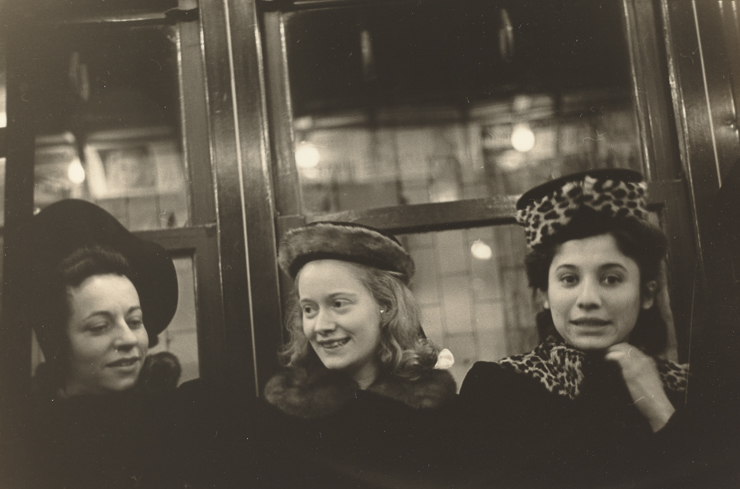
In Walker Evans’s Subway Portraits, an extensive series of many individual photographs, the artist hid a camera beneath his coat as he rode the New York City subway, capturing people traveling together or alone. Advances in camera portability and film and shutter speeds enabled Evans to discreetly take his photographs. Here, three young women occupy a single frame. Are they a group or just randomly associated by the photographer’s choice to shoot them together? Two appear to engage in conversation; the third, with the leopard-print hat and collar, looks preoccupied, with mouth grimacing slightly as she adjusts maybe a too-tight coat collar.
Walker Evans, Subway Portrait, 1938–1941, gelatin silver print, Gift of Kent and Marcia Minichiello, 1988.56.44

Philip-Lorca diCorcia’s photo, made some 60 years after Walker Evans took his surreptitious photos in the subway, was similarly taken without his subjects’ knowledge. DiCorcia hid some distance away with a camera equipped with a telephoto lens that permitted him to draw distant subjects close. He lit his unsuspecting subject with remote-controlled strobe lighting placed in the scaffolding of a building under construction. Using this set-up, his spontaneously chosen subjects were completely unaware of him. Like the young woman in the Walker Evans photograph in the previous slide, this image shows an individual lost in his thoughts or preoccupations. The artificial lighting, an unusual element in street photography, spotlights and lends drama to the unknown narrative of this man’s life.
Why do you think Walker Evans and Philip-Lorca DiCorcia photographed people without their knowledge or permission? Do you think this is OK?
Philip-Lorca diCorcia, Head #22, 2001, chromogenic print, Charina Endowment Fund, 2011.48.1